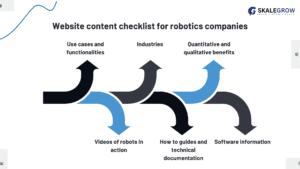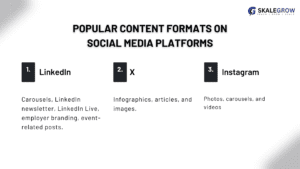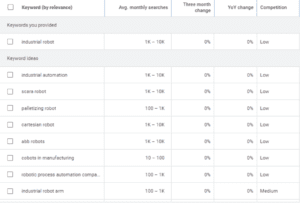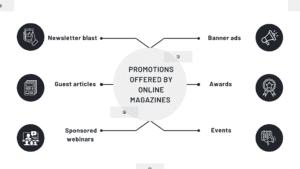Robots have been changing the way work is done across various industries – from medical to retail and industrial. According to Skyquest, the Global Robotics Market size was valued at USD 34.06 billion in 2022 poised to grow from USD 39.54 Billion in 2023 to USD 134.64 Billion by 2031, growing at a CAGR of 16.60% during the forecast period (2024-2031).
And with the adoption of AI, the number of use cases robots can serve has expanded and more and more startups are venturing into this space. Precedence research says that the global artificial intelligence (AI) robots market size reached USD 14.30 billion in 2023 and is estimated to be worth around USD 82.47 billion by 2032, growing at a CAGR of 21.50% from 2023 to 2032.
This clearly indicates that robots will be an inevitable part of our future life. However, the growing number of robotics companies will also mean an increase in competition. Today, many robotics companies tend to get easy attention because they have a cool product. But that is set to change.
The robotics industry is currently going through a phase like the late 90s and early 2000s of the IT and software industry when the product or solution sold by itself. But today, even the largest IT and software companies have to do aggressive marketing to stay in the game. The robotics space will see a similar shift in the next decade or so where active marketing efforts will be required to ensure they remain visible to their target audience.
I believe it is time for robotics companies to prepare for that era. They need to think much beyond tradeshows to promote their products. In essence, it is time that they seriously consider building a solid marketing engine, if they haven’t already.
In this article, we look at all the different marketing channels and related strategies robotics companies can use. As we learn the various tactics, we will also look at examples of robotics companies that are already doing great marketing.
What types of robots are we talking about?
Robots are of huge variety. They are sold to businesses as well as households. From robotic vacuum cleaners to goods to person robots and delivery robots, they find use cases in almost everything humans do.

A delivery robot
For example, a robotic vacuum cleaner is used to automatically clean houses and other buildings. On the other hand, a goods-to-person robot is used in large warehouses to take material from one place to another. Similarly, a delivery robot is used to deliver packages to customers. Some of the other types of robots used today include:
- Harvesting robots
- Drug delivery robots
- Autonomous tractors
- Telepresence robots
- Automated lawn mowers
- Patrol robots
- Service or companion robots
- Robotic arms
- Inspection robots
- Inventory tracking robots
- Automated forklifts
- Construction robots
You can add a few more to the list. But without a doubt, robots find applications in multiple sectors such as medical, industrial, agriculture, retail, education, and more.
The very core of robotics marketing
Whether you are selling to a warehouse or a household, visual marketing is extremely important. Writing a boring essay about the features of your robot will not attract many. At the same time, a catchy video that demonstrates the robot in action will have a far greater impact. Similarly, if you can use an infographic to explain the features and functionalities of the robot, that will easily standout compared to a text-only LinkedIn post.
In short, nothing beats marketing using visuals in the robotics space. We should keep this in mind while designing any marketing campaign.
B2B robotics vs. B2C robotics companies
A robotic vacuum cleaner manufacturer primarily targets household consumers. At the same time, a delivery robot company sells to an e-commerce or logistics business. So there will be minor differences when it comes to the marketing tactics as well. In this article, we will focus on B2B robotics companies that sell their products to other businesses.
14 marketing channels and strategies for modern robotics companies
Now let us explore the various marketing channels robotics companies can use. But rather than simply talking about them, we will discuss how they can be applied (and used) by robotics companies. We will also look at a ton of examples and sample marketing material to help you develop an in-depth understanding of the topic.
1. The website
We all know that website is a critical element in any company’s marketing weaponry. For a robotics company, below are the key L1 pages that should be included in the website:
- Home page
- About the Company
- Products
- Use cases/solutions
- Industries served
- Resources
- Contact us
The structure pretty much follows that of other business websites. However, it is important to ensure that you cover all the possible use cases your robot can address. For example, a single robot can be used for inspection as well as data collection. Boston Dynamics Spot is an example of this.
A common tendency that I see among robotics companies is to use generic words in their website copy instead of being specific. For instance, look at the below statement:
‘Robot X is an autonomous mobile robot that helps to improve productivity and scale your operations by reducing human involvement.’
While the above can be a beginning statement, you need to go on and explain how the robot helps specifically, such as:
‘Robot X automates material delivery within a warehouse, saving you at least 40% time and 20% costs, thereby enabling you to do more with less.’
To summarize, here is a website checklist for robotics companies from a pure content standpoint:

2. SEO (Search Engine Optimization)
There is a lot to talk about when it comes to SEO. But at a 10,000 feet level, it is about creating content around the right set of keywords. Ideally, you need to go after keywords with high volume and as low difficulty as possible. Check out this article on SEO-led content to learn in detail how to implement SEO for your website.
When you do keyword research, below are the different types of keywords you could explore:
- Product-related: This usually works if your product is already popular (think of the MiR250 from MIR Robotics as an example).
- Brand keywords
- Industry-specific keywords: e.g. industrial robot
- Solution or function-specific keywords: e.g. safety robot
- Topical keywords: e.g. warehouse automation robots
You could add 1 or 2 more categories depending on what kind of robots you are selling. But you get the idea here.
The best way to start a keyword analysis is to perform a content gap analysis (check out the below video to learn what content gap analysis is and how to do it the right way). Knowing the different types of keywords will help you finetune the entire process of keyword research and analysis.
3. Video marketing
If you asked me to pick one content format for a robotics company, I would go with videos. As I mentioned in the beginning, the best way to communicate what your products can help your customers achieve is by showing them in action through videos.
Are you selling a construction robot? Show how it eases various construction tasks. Can your robot be used for telepresence? Demonstrate how it eases remote communication and content delivery. Or is it a patrol robot used for surveillance? Then show how well it can capture images at night.
Whatever the robot is, use videos to show how it works in their real environments. Look at the below video from Stryker as an example.
You can also use videos for the following purposes:
- To showcase different use cases of the robot or how they can be used in different industries.
- To demonstrate the quality of its safety and security
- To show its endurance in harsh external conditions like high temperature, rain, snow, etc.
In addition to the above, you can also use videos just like how every other business uses them – to create educational videos, employer branding videos, event videos, webinars, etc.
4. Content marketing
Videos are part of content marketing. So is SEO. But here, I am referring to other content types such as:
- Ebooks and how to guides
- Whitepapers
- Survey and market research reports
- Case studies
- Product and application brochures
- Podcasts
A best practice for robotics companies when it comes to creating these content items is targeting both the key decision makers and end users. This is because purchasing robots and their adoption at the customer organization require buy-in from both segments.
For example, if you are trying to sell warehouse robots to an e-commerce company, the key decision makers is probably the Head of Automation, Chief Digital Officer, or even the Chief Operating Officer in some cases. While for the decision makers improving productivity, digitization, and cost reduction can be the highest priorities, for the warehouse staff (who are the end users), ease of use is of utmost importance.
To address this, you need to create content at two different levels – some for the decision makers and some for the end users. For example, you can have one podcast episode on the topic ‘How robots can save costs in an Industry 4,0 era’ and another one on ‘How robots improve worker safety in industrial settings.’
To be precise, the objective is to ‘influence’ people at different levels in your target organizations.
5. Email marketing
If you are building robots, an email newsletter is a must. Newsletters are one of the best ways to tell the world about what your robots are capable of. Consider doing it as a consolidated piece of curated content that include:
- Product updates
- Industry news (latest in robotics, AI, and automation)
- Your thought leadership content (article in a leading magazine, whitepaper, podcast episode, webinar, etc)
- Other content pieces: ebooks, case studies, videos, etc)
In addition to a newsletter, you can also experiment with cold emailing. But you need to make sure that you hit the nail with your messaging, email copy, and quality of the email list.
6. Social media marketing
No business can ignore social media in this digital era. This is even more true for robotics companies. And given that most social media platforms are trying to push videos (especially the shorter formats), you should definitely post them on LinkedIn, Instagram, X, and YouTube.
The below infographic lists a few preferred content formats across various social media platforms:

For B2B robotics companies, in general, LinkedIn is the best social media platform to establish their presence. Please read the below article to learn how to create content for LinkedIn organic marketing:
How To Create Content For LinkedIn Organic Marketing [With 10+ Examples And 5 Templates]
It is also important to note that depending on your target customer, the choice of platform could vary. For example, Facebook groups around robotics, AI, and automation have a huge member base. Hence, it’s worthwhile promoting your robotic solutions there too.
7. Performance marketing/ads
Ads work differently for different industries. Hence, it is important for you to experiment with them first and see if they benefit your business.
The very first step to doing this is to analyze your competitors’ ad strategy. You can use tools like Adbeat and Google Ads Transparency Centre to do this. If you see that many of your competitors are running ads, it is highly likely that they will work for you as well. But as I said, start by investing small amounts (say $25 to $50 per day) to see if ads really work for you.
Google search ads are a great place to start given they are intent driven and is relatively less expensive compared to LinkedIn ads. The key is to test your ads with different keywords and copy (remember the different keyword categories we talked about earlier?).
To help you develop a clear understanding about this, check out a few sample keywords that can be used for an industrial robot in the below screenshot:

Just like in the case of SEO, you need to pick keywords that have high volume and low competition. In addition to finalizing the keywords, you also need to decide the number of campaigns you would run and the ad groups and ads under each.
The next step is to write the titles and descriptions for the ads you wish to run. Keep in mind that titles have a character limit of 30 while it is 90 for descriptions.
Here is a set of sample title and description for promoting a warehouse robot:
Title: Warehouse Automation Robot
Description: Automate material handling | 2X Productivity | Cost Reduction by 40% | Easy Installation
8. Event marketing
Events give you the opportunity to show the people behind creating and selling amazing products at your company. There are plenty of shows you can take part in to promote your robotic solutions. This could vary depending on the type of product. But here a few examples of events that most robotics companies will find useful:
- Autonomous Mobile Robots & Logistics Conference 2024
- The Robotics Summit
- RoboBusiness
- International Conference on Robotics and Automation
You can add many more to the list by doing your own research. You can use methods like checking out event listing websites, finding events your competitors are taking (or have taken) part in, or even a simple Google search.
The only thing to note here is that the event should have a decent footfall that belong to your target audience. You can gauge this by looking at the past attendee list of these events. Most event organizers publish the list of companies that exhibited and experts who spoke at their events.
9. Webinar marketing
Here are a few recommendations to make the most out of your webinar marketing efforts:
- Include live demos in your webinar to make it more engaging and interesting.
- Announcing a new product feature or update is a great way to hook potential attendees.
- Live streaming to multiple platforms like YouTube, X, and LinkedIn can increase reach.
To learn everything about webinar marketing, please visit the below article:
Webinar Marketing – Everything You Need To Know
10. Online magazines and media websites
Online magazines and media websites are a great place to reach a niche audience. They offer various promotional opportunities like the ones shown in the below image:

Here are a few examples of online magazines and media websites in the robotics space:
11. Partnership marketing
Partnership marketing is one of the most underutilized marketing techniques in the robotics industry. It can be implemented in two ways:
- Partnering with companies that bring complementing capabilities. An example is a company that offers 3D imaging systems like LiDAR or stereo cameras.
- Working with companies that do not have a related capability but has a common target audience. An example is a company selling a WMS (Warehouse Management System) software. A warehouse robot company has a similar target audience.
Given below are a few ways in which robotics companies can execute partner marketing:
- Co-hosting webinars
- Collaborative articles (on their websites, LinkedIn, or online magazines)
- Social media posts tagging each other
- Co-participating in events and tradeshows
- Speaking at each other’s events
You can think about more ways of doing partnership marketing. As long as you choose the right partner and have a program in place for it, you should be able to make the most out of partnership marketing.
12. Public Relations
Public relations work very well for robotics companies, especially when you have new product launches or updates. Having your story featured in top magazines and media websites can get you great visibility and is excellent for branding.
Some of the websites we mentioned in the online magazines category offer the option to publish press releases and articles. You can also aim to get featured in more generic websites like Forbes, Techcrunch, The Verge, Business Wire, etc.
Related: Get free PR! Tell your story
13. Influencer marketing
Working with influencers in the robotics, automation, and AI space helps you reach audiences you otherwise wouldn’t be able to. The advantage robotics companies have is that they can tap into influencers who specialize in various industries as well. Examples include industry 4.0, smart retail, and home automation.
To identify influencers in your niche, you can use the below tools:
A normal search on LinkedIn or X can also help find influencers. Given that a lot of trending tech discussions happen on X, it’s a great place to start.
Related: Lean B2B Influencer Marketing: An Untapped Gem
14. Distributors
If you have distributors supplying your products, they can also add an extra push to your marketing efforts. For example, Universal Robots has distributors all over the world. While some of them are mere suppliers, a few are actively involved in marketing their products too.
Distributors can be helpful particularly in non-English speaking countries like Japan and Korea where it is not just the language that could be a barrier but the cultural nuances too. Working with a distributor can enhance your marketing communication in such a scenario.
Final words
It is practically impossible to cover everything related to marketing in robotics companies in a single article. There will be more coming up in this series soon. However, I recommend you do your own further reading and take inspiration from what your competitors are doing right. Also, don’t hesitate to run experiments as I believe marketing robots still doesn’t have a standard framework or methodology to it. Given this, you could set a great example for the industry if you create a system and path for others to follow.
Skalegrow – marketing agency for robotics companies
Skalegrow is the only marketing agency in India (and one among a few globally) to specialize in marketing robots. We understand how the industry works and what can make your product attractive to your target audience – whether you are selling to hospitals or construction companies. We focus on generating demand for your products by producing high-quality content and marketing campaigns that standout. Our services include content marketing, SEO, video marketing, ,email marketing, graphic design, LinkedIn marketing, performance marketing, and website management.
So, if you are looking for a marketing partner that is laser-focused on robotics, look no further than Skalegrow. You can get in touch here or reach out to us at info@skalegrow.com for a detailed discussion.
About the author

Naseef KPO is the Founder and CEO of Skalegrow. He comes with rich experience across multiple areas of B2B marketing including content marketing, demand generation, SEO, account-based marketing, marketing analytics, revenue attribution, marketing technology, etc. He writes thought-provoking and relevant articles on The Skalegrow Blog and his weekly LinkedIn newsletter Elevate Your Marketing.
Prior to starting Skalegrow, Naseef led large marketing teams in multi-million dollar B2B organizations where he made significant contributions to the topline growth of the business. He has also appeared on numerous podcasts where he shared his thoughts on trending marketing topics such as the application of AI in marketing, startup marketing, ABM, and B2B content marketing, just to name a few. Being the founder of Skalegrow, he is currently focusing on helping its clients stay ahead of their competition by using innovative yet practical marketing tactics.
You can connect with Naseef KPO on LinkedIn.


